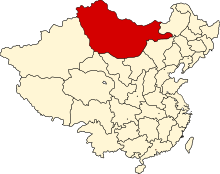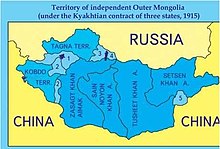
Back Buite-Mongolië Afrikaans Знешняя Манголія Byelorussian Външна Монголия Bulgarian Mongòlia Exterior Catalan Vnější Mongolsko Czech Ekstera Mongolio Esperanto Mongolia Exterior Spanish مغولستان بیرونی Persian Mongolie-Extérieure French מונגוליה החיצונה HE




Outer Mongolia[a] was the name of a territory in the Manchu-led Qing dynasty of China from 1691 to 1911. It corresponds to the modern-day independent state of Mongolia[b] and the Russian republic of Tuva. The historical region gained de facto independence from Qing China during the Xinhai Revolution.
While the administrative region of Outer Mongolia during the Qing dynasty only consisted of the four Khalkha aimags (Setsen Khan Aimag, Tüsheet Khan Aimag, Sain Noyon Khan Aimag, and Zasagt Khan Aimag), in the late Qing period, "Outer Mongolia" was also used to refer to the combined Khalkha and Oirat regions, as well as the directly-ruled Tannu Uriankhai.
Much of the region was subsequently claimed by the Republic of China, which had acquired the legal right to inherit all Qing territories through the Imperial Edict of the Abdication of the Qing Emperor, as an integral part of the state. This is referred to as "Mongolia Area" to distinguish it from Outer Mongolia.[3][4][5] Most of Outer Mongolia, however, was under the de facto control of the Bogd Khanate, which was largely unrecognized internationally. The Republic of China briefly established de facto rule over most of the region from 1919 to 1921. After the Mongolian People's Republic was founded in 1924, the Nationalist government of China de jure recognized Mongolian independence in 1946 under Soviet pressure,[6] though this recognition was later rescinded by the Kuomintang government which had retreated to Taiwan due to continued Soviet support to the Chinese communists.[7] The People's Republic of China continued recognition of the Mongolian People's Republic and established full diplomatic relations with Mongolia since its establishment.[8]
- ^ Huhbator Borjigin. 2004. The history and political character of the name of 'Nei Menggu' (South Mongolia). Inner Asia 6: 61-80.
- ^ "History of Mongolia". Embassy of Mongolia in Washington.
- ^ Esherick, Joseph; Kayali, Hasan; Van Young, Eric (2006). Empire to Nation: Historical Perspectives on the Making of the Modern World. p. 245. ISBN 9780742578159. Archived from the original on 23 June 2021. Retrieved 5 December 2020.
- ^ Zhai, Zhiyong (2017). 憲法何以中國. p. 190. ISBN 9789629373214. Archived from the original on 23 June 2021. Retrieved 21 July 2021.
- ^ Gao, Quanxi (2016). 政治憲法與未來憲制. p. 273. ISBN 9789629372910. Archived from the original on 23 June 2021. Retrieved 21 July 2021.
- ^ Friters, Gerard M (1974). Outer Mongolia and its International Position. New York: Octagon Books.
- ^ "Taiwan Veto Likely; Taipei Regime May Again Bar Outer Mongolia From U.N.", The New York Times, 22 April 1961, archived from the original on 22 July 2018, retrieved 5 February 2008
- ^ "China-Mongolia Boundary" (PDF). International Boundary Study (173). The Geographer, Bureau of Intelligence and Research: 2–6. August 1984. Archived from the original (PDF) on 2006-09-16. Retrieved 2008-06-16.
Cite error: There are <ref group=lower-alpha> tags or {{efn}} templates on this page, but the references will not show without a {{reflist|group=lower-alpha}} template or {{notelist}} template (see the help page).
© MMXXIII Rich X Search. We shall prevail. All rights reserved. Rich X Search